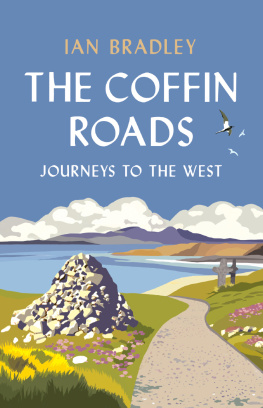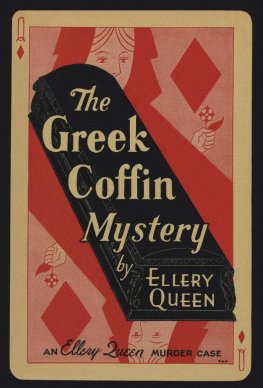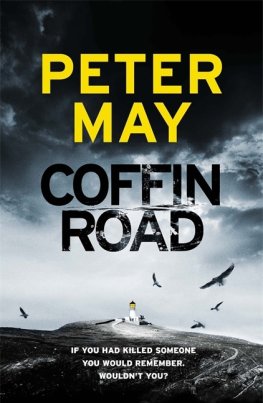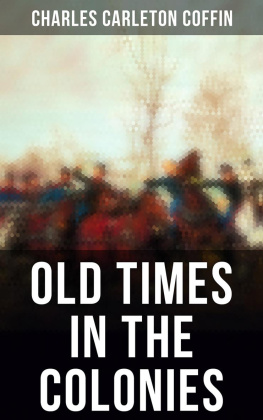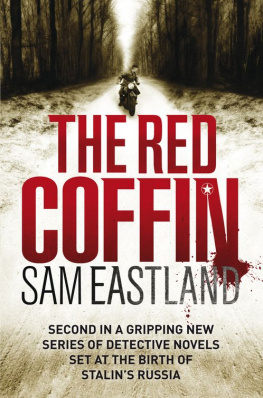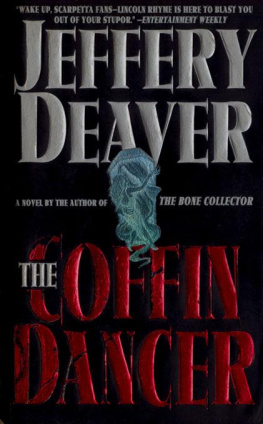Ian Bradley - The Coffin Roads: Journeys to the West
Here you can read online Ian Bradley - The Coffin Roads: Journeys to the West full text of the book (entire story) in english for free. Download pdf and epub, get meaning, cover and reviews about this ebook. year: 2022, publisher: Birlinn, genre: Religion. Description of the work, (preface) as well as reviews are available. Best literature library LitArk.com created for fans of good reading and offers a wide selection of genres:
Romance novel
Science fiction
Adventure
Detective
Science
History
Home and family
Prose
Art
Politics
Computer
Non-fiction
Religion
Business
Children
Humor
Choose a favorite category and find really read worthwhile books. Enjoy immersion in the world of imagination, feel the emotions of the characters or learn something new for yourself, make an fascinating discovery.
- Book:The Coffin Roads: Journeys to the West
- Author:
- Publisher:Birlinn
- Genre:
- Year:2022
- Rating:3 / 5
- Favourites:Add to favourites
- Your mark:
- 60
- 1
- 2
- 3
- 4
- 5
The Coffin Roads: Journeys to the West: summary, description and annotation
We offer to read an annotation, description, summary or preface (depends on what the author of the book "The Coffin Roads: Journeys to the West" wrote himself). If you haven't found the necessary information about the book — write in the comments, we will try to find it.
Ian Bradley: author's other books
Who wrote The Coffin Roads: Journeys to the West? Find out the surname, the name of the author of the book and a list of all author's works by series.
The Coffin Roads: Journeys to the West — read online for free the complete book (whole text) full work
Below is the text of the book, divided by pages. System saving the place of the last page read, allows you to conveniently read the book "The Coffin Roads: Journeys to the West" online for free, without having to search again every time where you left off. Put a bookmark, and you can go to the page where you finished reading at any time.
Font size:
Interval:
Bookmark:

Ian Bradley is Emeritus Professor of Cultural and Spiritual History at the University of St Andrews. Among his many books are Pilgrimage: A Cultural and Spiritual Journey (2009), Argyll: The Making of a Spiritual Landscape (St Andrew Press, 2015), Following the Celtic Way (Darton, Longman & Todd, 2018) and The Fife Pilgrim Way (Birlinn, 2019).
The Coffin Roads: Journeys to the West is the second in a trilogy of books on aspects of death and the afterlife. The first, The Quiet Haven: An Anthology of Readings on Death and Heaven, was published in 2021 by Darton, Longman & Todd and the third, Breathers of an Ampler Air: Heaven and the Victorians, is due to be published by the Sacristy Press in 2024.
The Coffin Roads
Journeys to the West
Ian Bradley

First published in 2022 by
Birlinn Limited
West Newington House
10 Newington Road
Edinburgh
EH9 1QS
www.birlinn.co.uk
Copyright Ian Bradley 2022
The right of Ian Bradley to be identified as Author of this work has been asserted by him in accordance with the Copyright, Designs and Patents Act 1988.
All rights reserved. No part of this publication may be reproduced, stored or transmitted in any form without the express written permission of the publisher.
ISBN: 978 1 78027 779 0
British Library Cataloguing-in-Publication Data
A catalogue record for this book is available from the British Library
Typeset by Initial Typesetting Services, Edinburgh
Papers used by Birlinn are from well-managed forests and other responsible sources

Printed and bound by Clays Ltd, Elcograf S.p.A.
I have derived considerable benefit from conversations with Dr Lorn Macintyre, Alastair McIntosh, Iain Thornber, Lord Bruce Weir, Canon John Paul MacKinnon, Father William Fraser and Father Roddy Johnston. I am grateful to Iain Thomson for permission to quote from Isolation Shepherd, to Dr Mickey Vallee for permission to quote from the 1955 article by his grandfather, Professor Frank Vallee, on burial practices in Barra, and to John Bell and the Wild Goose Resource Group for permission to quote The Last Journey. Hugh Andrew and Andrew Simmons of Birlinn have been consistently supportive and helpful. Helen Bleck has been a meticulous copy editor.

This map shows only the coffin roads and graveyards featured in the numbered chapters and not those mentioned in the Introduction
Walkers and cyclists exploring the Highlands and Islands of Scotland are very likely to find that coffin roads feature on their itineraries alongside drovers tracks and other traditional rights of way. Some of the most popular and well publicised walks in the west of Scotland carry this somewhat macabre designation. Perhaps the most frequented is the five-mile Stoneymollan coffin road from Balloch to Cardross, which forms part of both the John Muir Way and the Three Lochs Way, and links Loch Lomond with the Firth of Clyde.
Longer coffin roads are to be found rather further afield in the north-west Highlands. They include several challenging routes promoted on websites like ScotWays Heritage Paths and Walkhighlands, such as the nine-mile path from Kenmore to Applecross, the 26-mile Kintail coffin road from Glen Strathfarrar to the graveyard at Clachan Duich on the north shore of Loch Duich and the 28-mile Bunavullin coffin road which crosses Morvern from Bunavullin to Laudale House on Loch Sunart.
Another lengthy coffin road, which has been researched by the South Loch Ness Heritage Group, is thought to have extended for 25 miles from Whitebridge on the east side of Loch Ness to the burial ground at St Kenneths Church at the north end of Loch Laggan. It went over the Monadhliath hills and through Glen Markie, crossed the Spey at Crathie and then passed Loch Crunachdan before reaching its destination at Kinlochlaggan. Early Ordnance Survey maps show Cnocan nan Cisteachan to the west of Loch Crunachdan as the Hillock of the Coffins. Shorter walks along coffin roads include the one-and-a-half mile Bohenie coffin road, which goes through Glen Roy from Bohenie to Achluachrach in Lochaber, the two-mile track along the north side of Loch Moidart from Glenuig to Kinlochmoidart, and the two-and-a-half mile track which climbs through native birch-wood from near Abriachan on the northern side of Loch Ness.
There are also numerous coffin roads on the islands of the Outer and Inner Hebrides, the best-known perhaps being the four-mile track that crosses the south of Harris from Leacklea (sometimes spelled as Lacklee or Leac-a-li) near the head of Loch Stockinish in the Bays area on the east of the island to Trigh Losgaintir on the west. Known as the Bealach Erabhat, it stood in for the desolate landscape of Jupiter in Stanley Kubricks 1968 film 2001: A Space Odyssey, which included helicopter shots of the route. It also provides the title for Peter Mays best-selling ecothriller, Coffin Road, first published in 2016, which begins with the central protagonist being washed up ashore on Luskentyre beach (Trigh Losgaintir) on the south-west coast of Harris. He has lost his memory and has no idea who he is or how he has come to be there. The only clue that he can find is a folded Ordnance Survey Explorer Map of South Harris, on which he has highlighted with a marker pen the route of the Bealach Erabhat. So it is on that coffin road that he begins the search for his lost identity. There are well-attested coffin roads on Mull and Barra.
As their name implies, these ancient and well-worn tracks were developed so that the bodies of the dead could be carried for burial to the remote graveyards that are still such a feature of the West Highland and Hebridean landscapes. They tended to be specially designated for this purpose, and to be distinct from routes along which the living would pass on their daily business, although several were later adopted as public tracks and roads. Journeys along the coffin roads were often lengthy and arduous, with relays of six or eight men carrying the coffin either on their shoulders or on long spokes. They would stop at frequent intervals for rest and refreshment and to be relieved by another bearer party. The slow progress on foot from place of death to place of burial could sometimes last for two or three days and nights and involve several hundred bearers and mourners walking through wild and desolate country with their food, drink and bedding carried by packhorses.
Along the routes of many of the coffin roads, cairns were erected, as illustrated on the front cover of this book. Some of them can still be seen today. They marked the places where the bearer parties stopped to rest. In some cases, the cairns may even have provided a platform on which the coffin was rested. Those carrying coffins would either build a small cairn to commemorate the dead at each resting place or add stones to an existing cairn along the route so that the resting cairns gradually grew in size. Perhaps the most spectacular ones that can still be seen today are the four prominent cairns on Dun Scobull on the Ardmeanach peninsula on southeast Mull, which mark the place where the coffins of successive generations of the MacGillivray family were rested on their way to be buried at Kilfinchen churchyard. On his travels through the Highlands in 1927, Thomas Ratcliffe Barnett saw several heaps of coffins on the Glensherra road between Loch Crunachdan and Loch Laggan. I have not myself been able to verify if they are still visible today, but I have seen small heaps of stones beside the old coffin road along the south side of the Morvern peninsula between Fiunary and the graveyard at Kiel Church (see pp. 667).
Font size:
Interval:
Bookmark:
Similar books «The Coffin Roads: Journeys to the West»
Look at similar books to The Coffin Roads: Journeys to the West. We have selected literature similar in name and meaning in the hope of providing readers with more options to find new, interesting, not yet read works.
Discussion, reviews of the book The Coffin Roads: Journeys to the West and just readers' own opinions. Leave your comments, write what you think about the work, its meaning or the main characters. Specify what exactly you liked and what you didn't like, and why you think so.

